INDUSTRIAL & TERMINAL RAILROADS &
RAIL-MARINE OPERATIONS
OF BROOKLYN, QUEENS, STATEN
ISLAND, BRONX &
MANHATTAN:
|
WALLABOUT
TERMINAL DELAWARE, LACKAWANNA & WESTERN RAILROAD |
|
DL&W
.
|
updated: |
||
|
|
||
|
update summary: |
date: |
chapter: |
| 1898 property map added | 08 November 2022 | History |
| 1927 Railway Age article on Electrification of Wallabout Terminal | 01 November 2022 | Electrification |
| Brooklyn Daily Eagle newspaper articles added overall view of terminal from roof of Sanitation Pier 1 images added undated image of 4001 added |
30 October 2022 | History Trackage Locomotive Photos |
.
.

| Trackage | Electrification | |
| Float Bridge | Locomotive Overview & Photos | Locomotive Roster builders data, disposition info |
.. ..
.
The Wallabout Terminal of the Delaware, Lackawanna & Western (DL&W) Railroad, was located at the intersections of Kent Avenue, Washington Avenue and Clymer Street in Williamsburg, Brooklyn. This location also corresponded to the marine intersection of the Wallabout Basin and the Wallabout Canal as well.
Initial research of this facility by this author failed to provide a start of operations date for this facility. Thanks to Joe Roborecky, submitted the following information from a Google Book Search, where he located the Brooklyn Daily Eagle Almanac of 1901, in which it states:
"At Cross st., fronting on Wallabout channel, to Wallabout Canal, is the Brooklyn terminal of the Delaware, Lackawanna & Western R.R. Co., constructed and put into operation during the last year. It is equipped with a car transfer bridge, has a two story brick building, at which 75 to 100 car loads of freight may be handled daily, and yard track delivery capacities for 90 additional cars."
Also located on the web, are these newspaper articles:
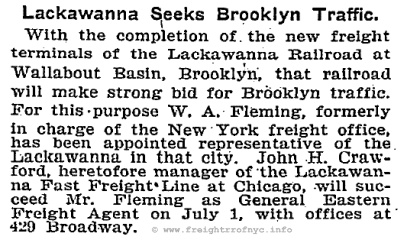 |
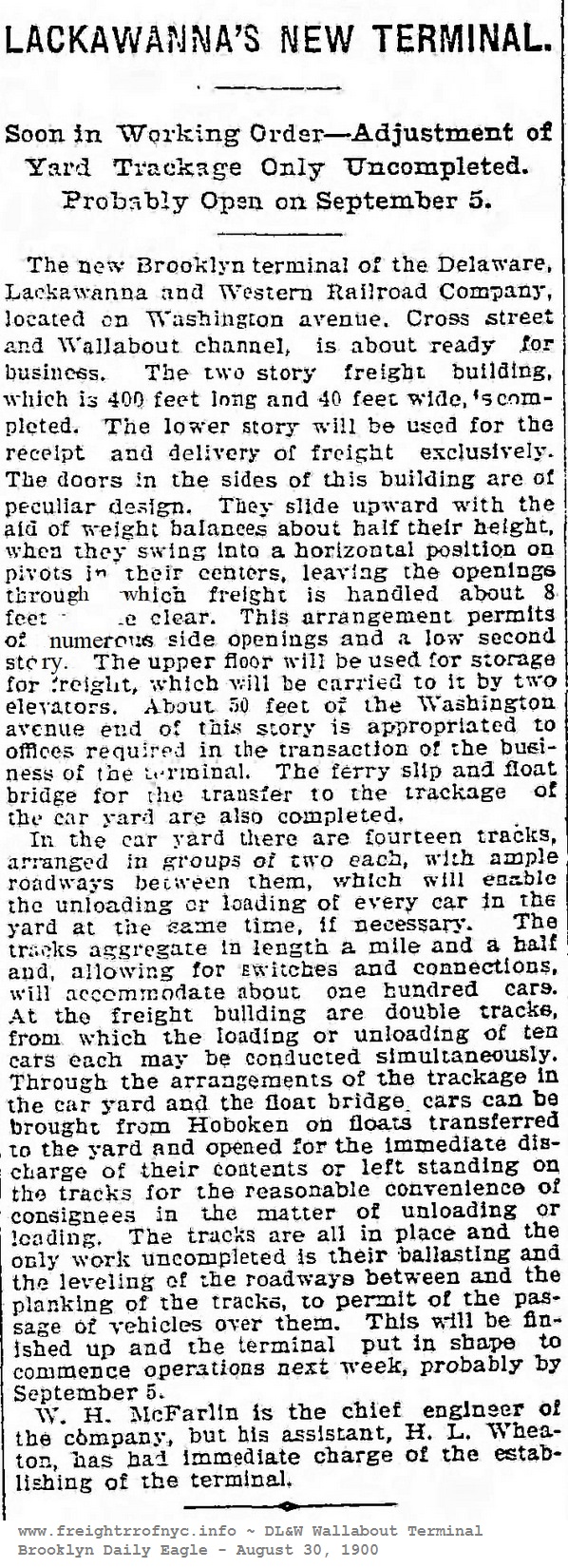 |
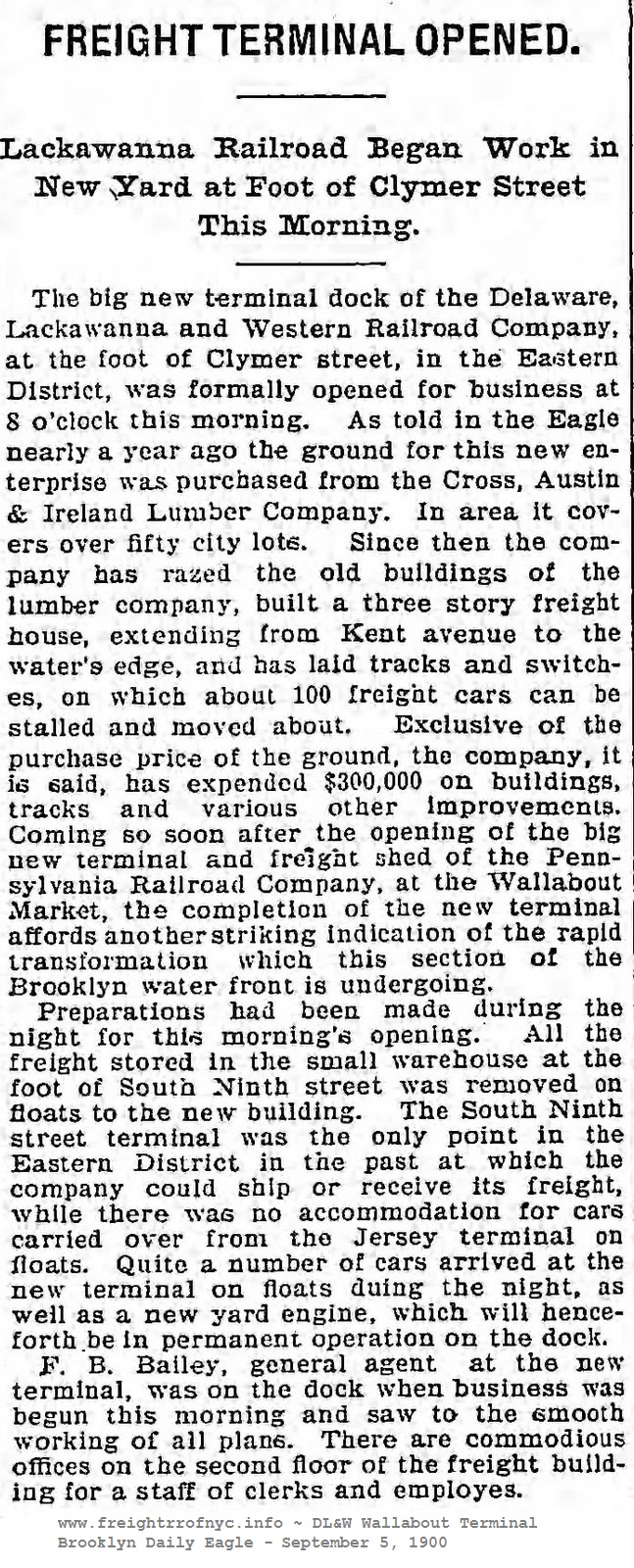 |
| New York Times - June 19, 1900 | Brooklyn Daily Eagle - August 30, 1900 | Brooklyn Daily Eagle - September 5, 1900 |
.
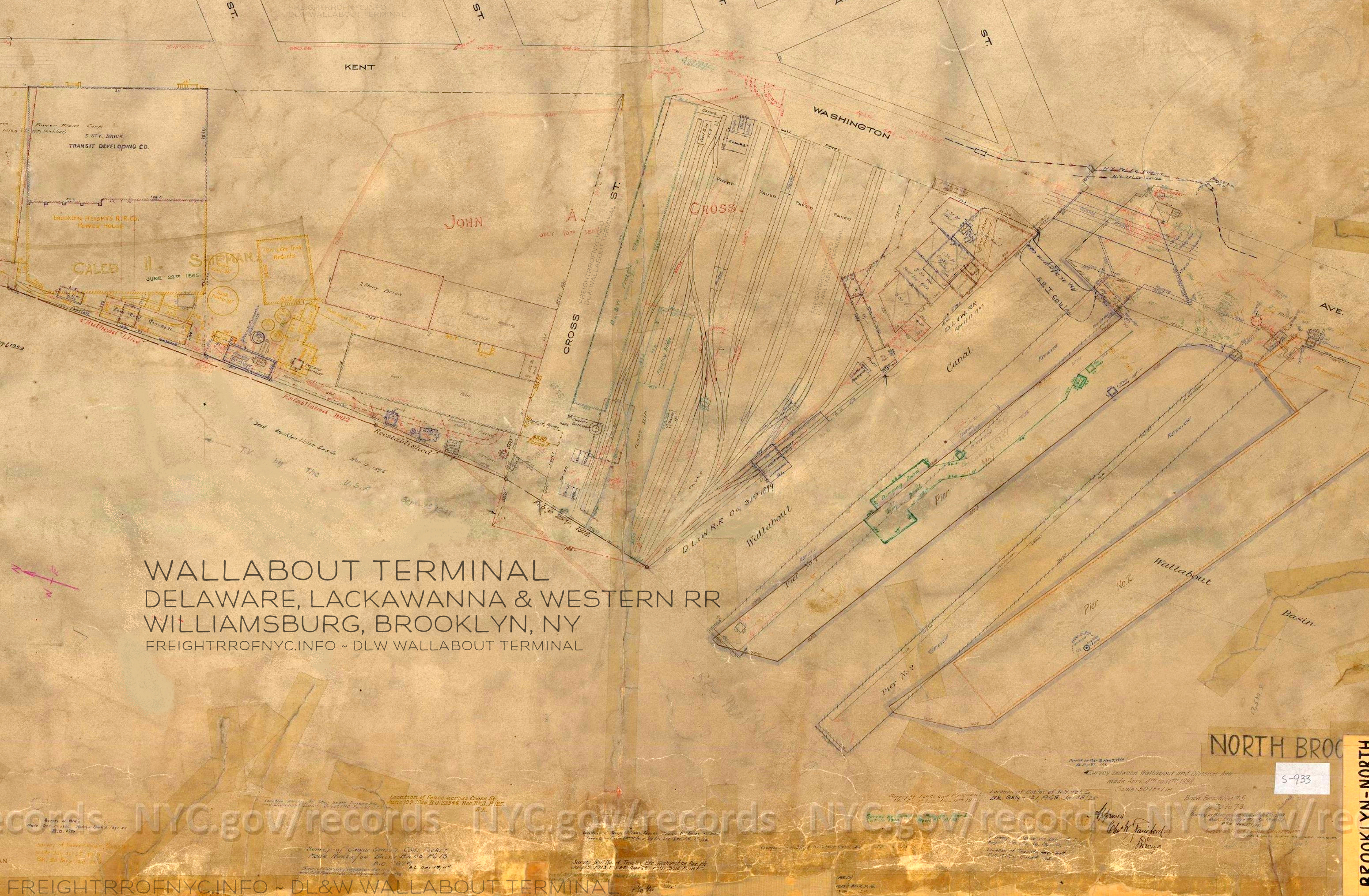
Brooklyn North 10 - Pier 1 & 2; Pier and Bulkhead lines; floating bridge, Wallabout Basin - April 4, 1898
courtesy of
New York City - Department of Records & Information Services
added 08 November 2022
..
.
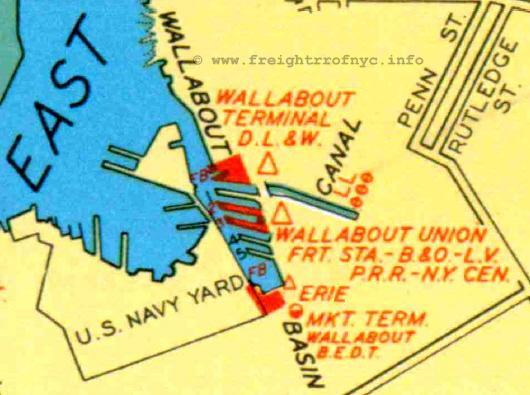
Do not confuse this facility with the other "Wallabout Terminals", operated by other railroads in the immediate vicinity:
| Wallabout Union Freight Station | of the Baltimore & Ohio, Lehigh Valley, Pennsylvania and New York Central Railroads sharing this "pier station only" facility; |
| Wallabout Station | the Erie Railroad freight house / Dressler's Wharf; |
| Wallabout Market Terminal | of the Brooklyn Eastern District Terminal, which
was the only other carfloat terminal and was located
at the very head of the Wallabout Canal and adjacent to the Brooklyn Navy Yard. |
We know the DL&W facility closed in 1941 when the United Stated Government expanded the New York Naval Shipyard a/k/a Brooklyn Navy Yard and seized the properties surrounding the Wallabout Basin.
On 09 February 2010, and after corresponding with Jon Franz regarding various Delaware, Lackawanna & Western Railroad operations in the New York Area, I received a package of documents from him.
Within this package, was a three page letter dated November 11, 1941 and issued by the Delaware Lackawanna & Western Railroad, Office of Superintendent, Hoboken, NJ. At the time of this letter, the Superintendent was Perry Shoemaker.
His letter is quite interesting, and while it pertains to the
official date of cessation of operations at Wallabout, it also specifically
lists:
.
|
|
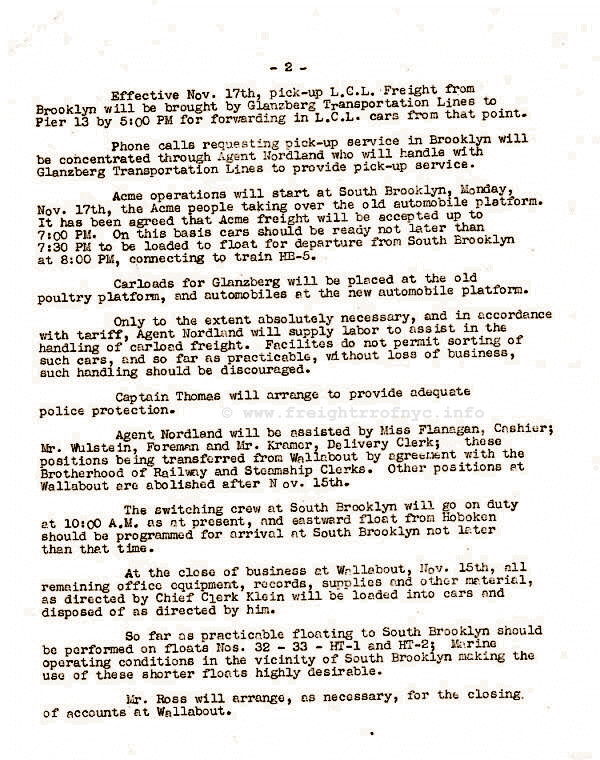 |
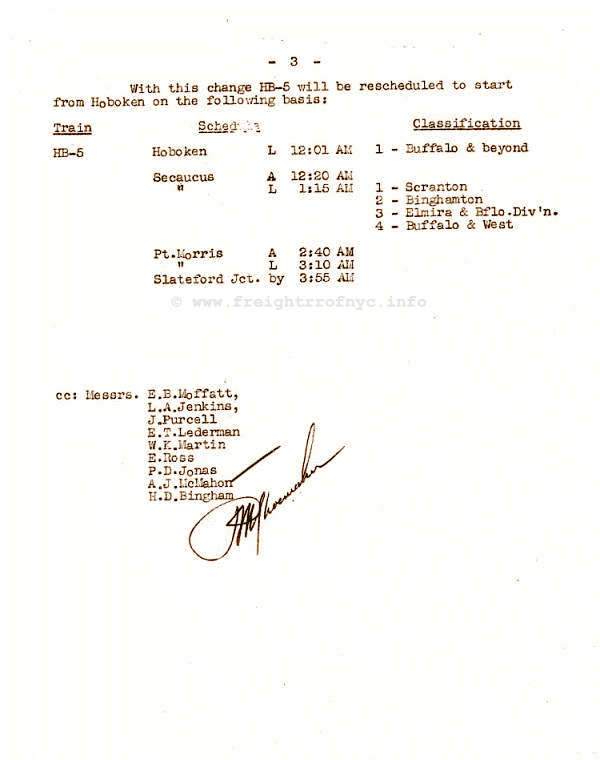 |
|
|
courtesy of J. Franz |
|
.
All in all, this document is a most revealing look at the closure of Wallabout Terminal and the transfer of services from that facility to 25th Street.
Unfortunately, very little information on this terminal has been located to date. Anyone with information, data or photographs of equipment or property, is most welcome to contact the author at bedt14@aol.com .
.
.
.
.
The following article was discovered within the Official Proceedings of September 1900 for the monthly meeting of the Western Railway Club. In this discussion, it specifies the design and components of the trackage, as well as the freighthouse and how the locomotive is used at the Wallabout Terminal:
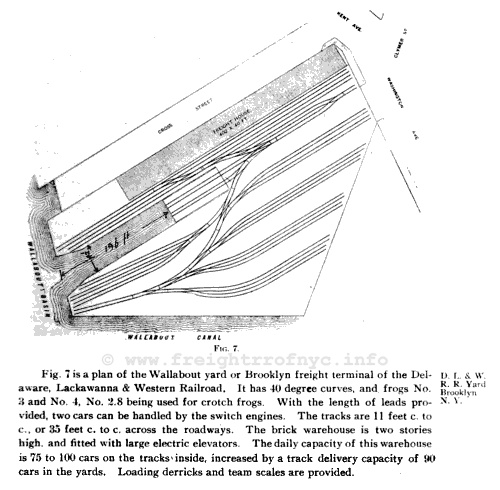
Official Proceedings of the Western Railway Club -
September 1900
added 22 October 2010
.
According to the track plan and specifications below and located in the book "Yards and Terminals and their Operation", John A. Droege, 1906. The diagram appears to be larger version of the same diagram as the one above.
.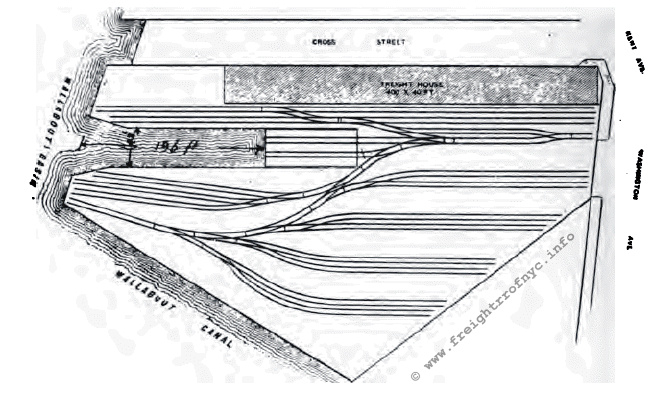
Yards and Terminals and their Operation - 1906
John A. Droege
.
The freight house dimensions were 40 feet by 400 feet. Tracks are on 11 foot centers, roadways 35 feet between centers of tracks, 40 degree track curves and #2.8, #3 and #4 frogs are in use on the track turnouts.
According to the "Report of the Committee on Terminals and Transportation of the New York State Food Investigating Commission" published April 18, 1913; it lists the capacity of the freight house at the Delaware, Lackawanna & Western Wallabout Terminal at 16,311 square feet and the terminal with 1.36 miles of trackage.
In the 1924 Fairchild Aerial Survey photo seen below, we can clearly make out the freighthouse, float bridge and the railyard.
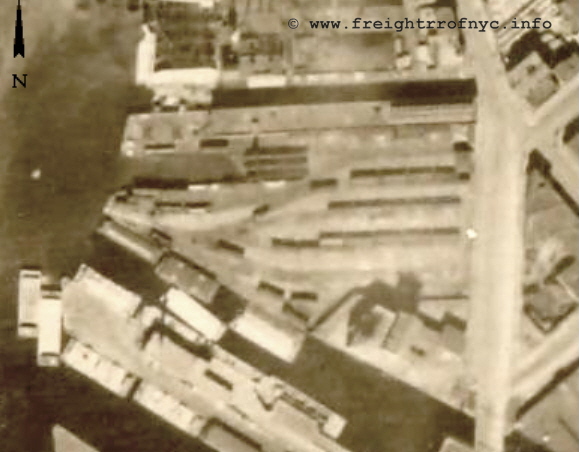
Fairchild Aerial Survey Photo - 1924
NYPL Digital
Archives
added 09 Dec 2008
.
An interesting aspect of the Wallabout Terminal was it would be completely powered by overhead catenary after 1926. While Bush Terminal and New York Dock (briefly) would utilize overhead catenary for street running operations, their yard operations were of steam locomotive operation; and all of which subsequently became diesel electric powered. The DL&W Wallabout operation would be completely electric.
As a result of the very contentious Kaufman Act legislated in 1923; the Delaware, Lackawanna & Western Railroad opted for and installed a 600 volt DC overhead catenary system in 1926 at the Wallabout Terminal; as opposed to employing the very new (and relatively unproven) technology of diesel-electric locomotives.
You can read the comprehensive history of all steam locomotive restrictions for the City of New York, beginning 1834 and ending with the Kaufman Act and its repeal on the main page of this website: Steam Locomotive Regulations within the City of New York. It is very much worth a read, because there are many misconceptions and hidden facts about the Kaufman Act, i.e. such as it was found unconstitutional by the US Statutory Court in 1926, and as a result repealed in 1930.
It is believed (but as yet unconfirmed) that with the Brooklyn Rapid Transit electric generating station immediately neighboring the north property line of the Wallabout Terminal, it is understood they could buy their power with minimal expense and transmission infrastructure.
This location would remain strictly a electric operation throughout its remaining history until 1941, at such time when the Navy Department appropriated the property to expand the Brooklyn Navy Yard.
Since #4001 was constructed in 1926, it can be hypothesized
confirmed that the Delaware, Lackawanna & Western responded to the enactment of
the Kaufman Law of 1923, by electrifying their Wallabout Terminal operation,
and thereby complying with the recently enacted anti-smoke legislation.
This overhead electric operation would be unique to offline terminal operations in New York Harbor, including the fact that the overhead wire was carried right to the end of the float bridge. No other offline terminal in the New York area operated as a strictly electric operation. Keeping in mind, that the South Brooklyn Railway (which commenced operations in 1903 and remained electrified until after World War II) but they did not operate a float bridge, and was not be considered an offline terminal.
Nor could comparison be made to the joint New York, New Haven & Hartford / Long Island Railroad operations at Bay Ridge - 65th Street Yard, where catenary also extended to the float bridge. However, the Bay Ridge Branch was connected to the "online" trunk railroad system; in other words - the Bay Ridge Branch was electrified for regular operations, and not isolated to an offline terminal yard. The Bay Ridge Branch catenary connected to trackage that led over the Hell Gate Bridge and by virtue, the Bronx, Westchester County and then Connecticut and points north; which undoubtedly is mainland United States.
All being told, this Wallabout Terminal was undoubtedly a unique operation.
On November 1, Bob Rickey forwarded the following article from Railway Age issues from 1927. It explains at length the catenary system utilized at the Wallabout Terminal.
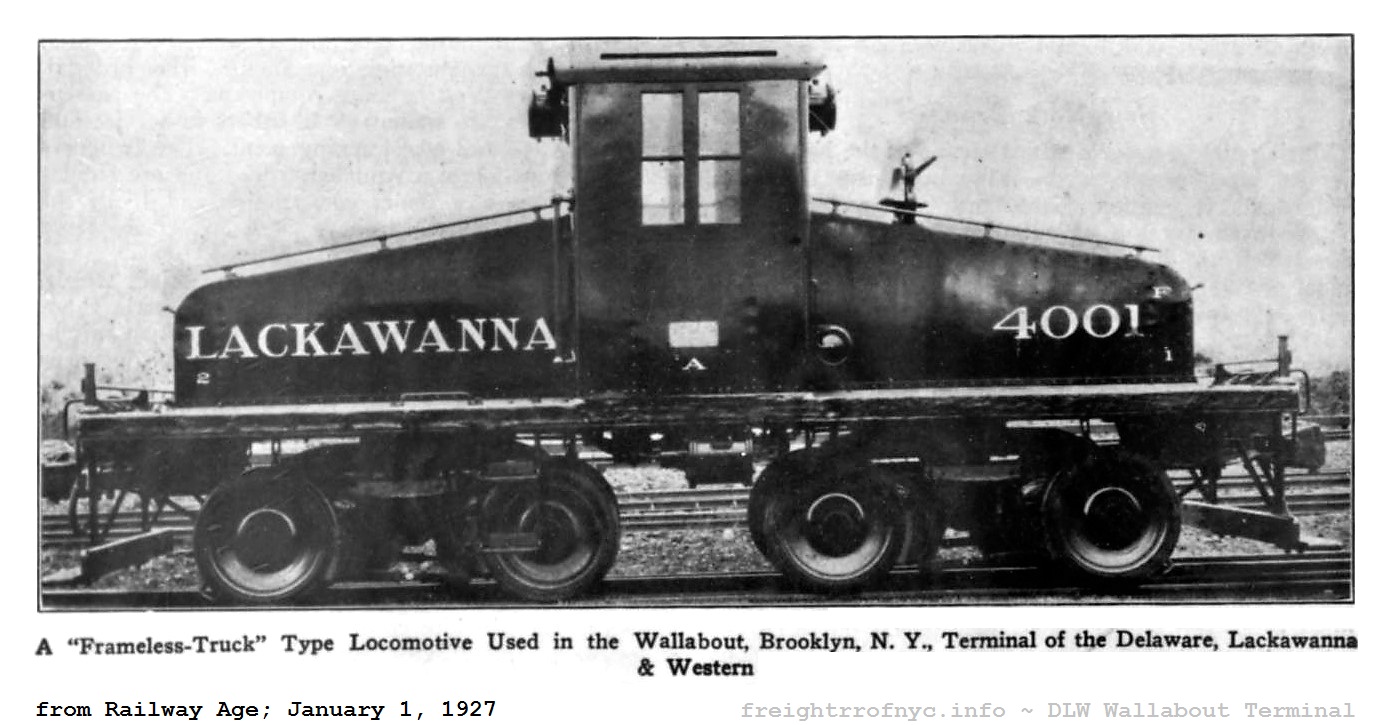 |
|
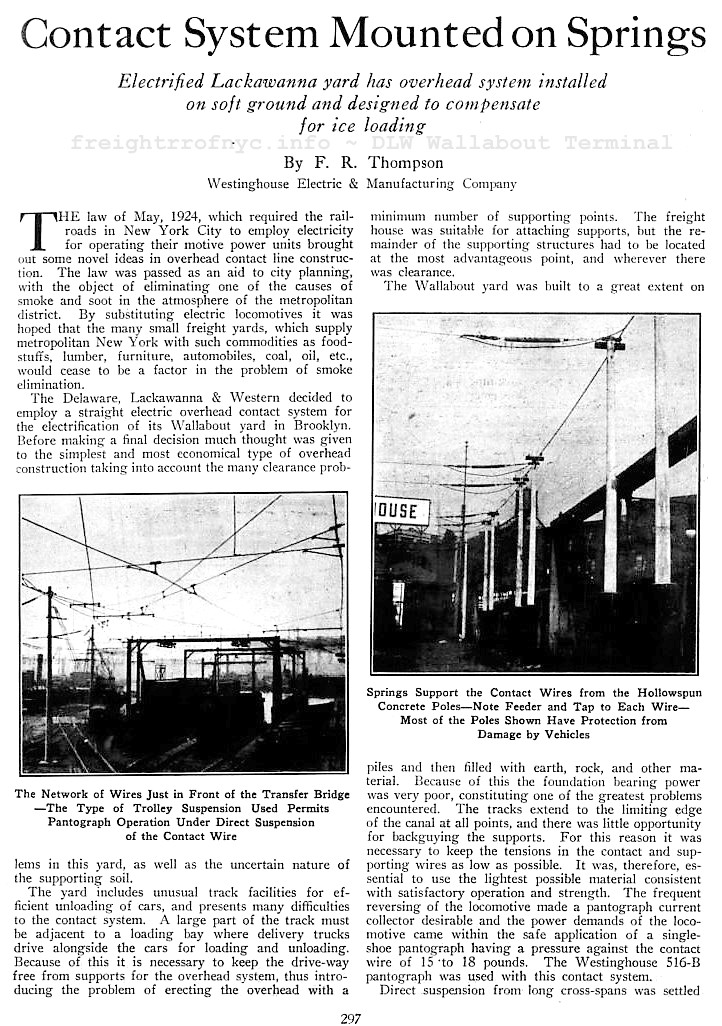 |
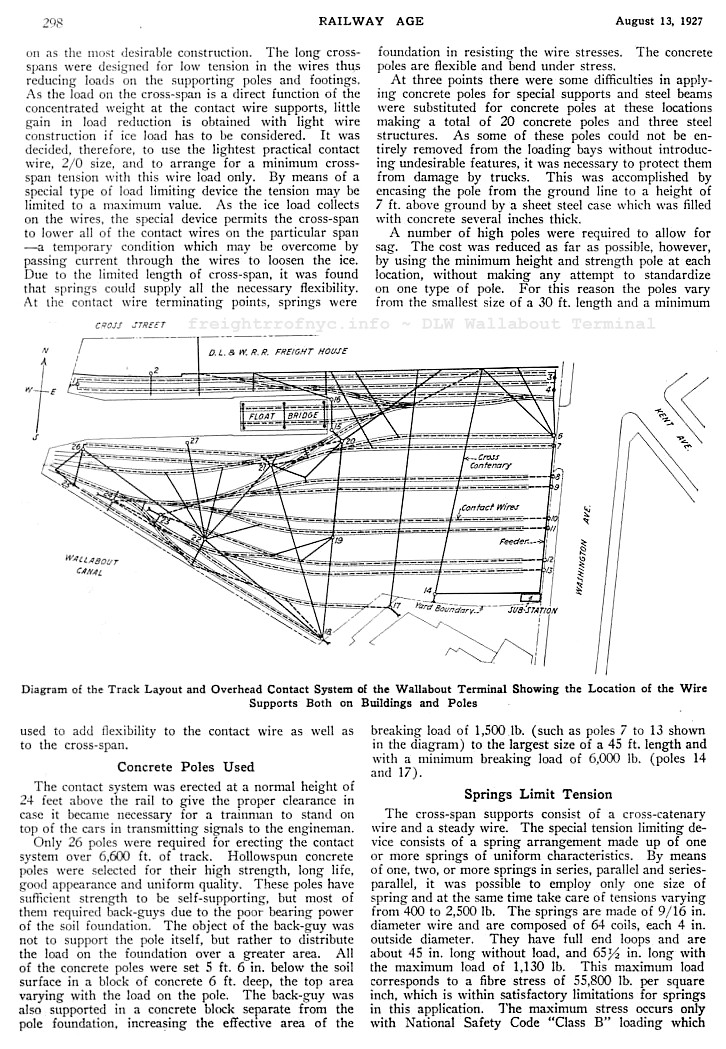 |
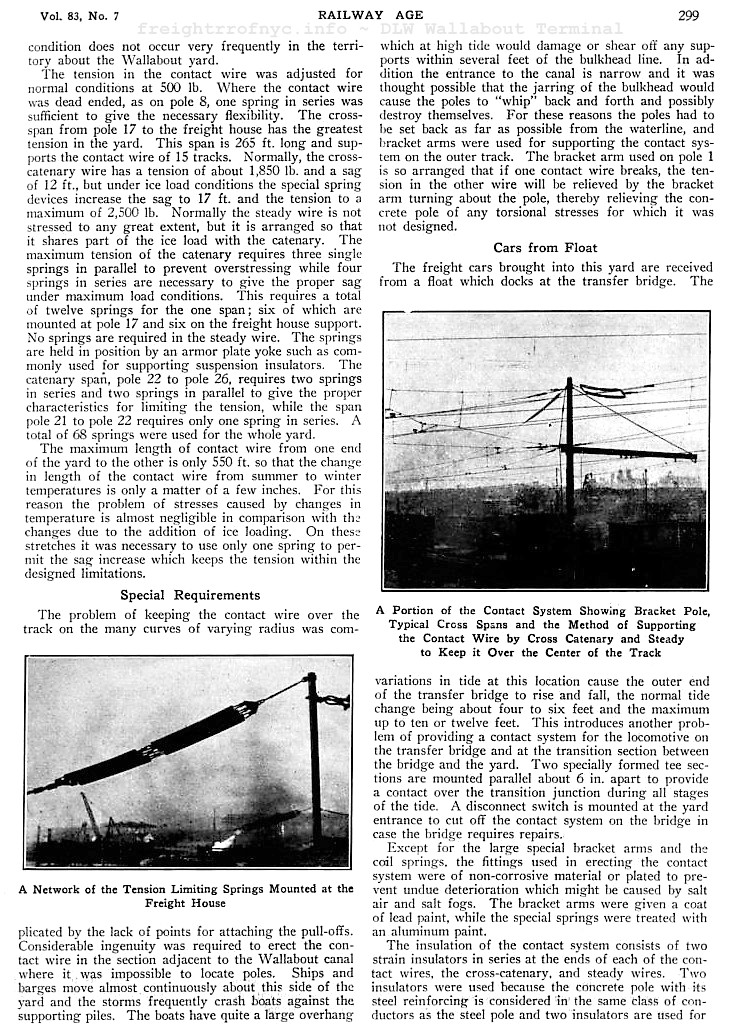 |
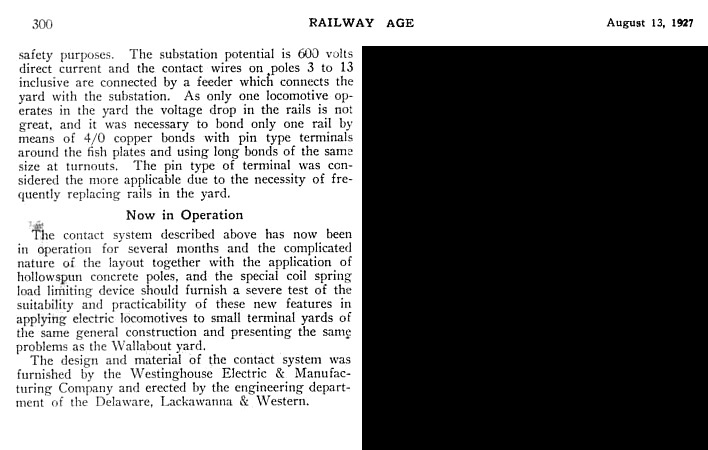 |
| Railway Age; Volume 83, №. 7- August 13, 1927 contributed by Bob Rickey added 01 November 2022 |
|
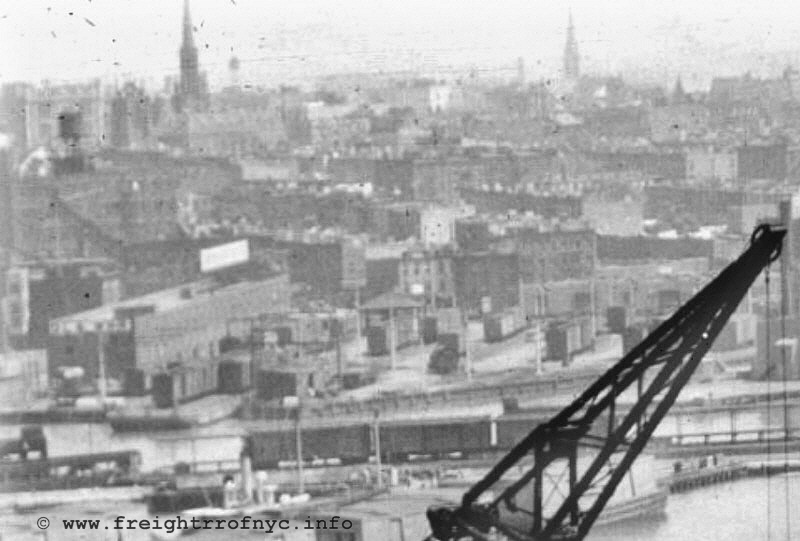
August 25, 1933
(The Delaware Lackawanna & Western Wallabout Terminal is the yard with
the white poles.
The three boxcars are on a station carfloat moored to the Clinton Avenue
bulkhead and
attached to the Brooklyn Navy Yard float bridge to the left.)
unknown photographer
Brooklyn Navy Yard Development Corp Archives
added 04 May
2009
.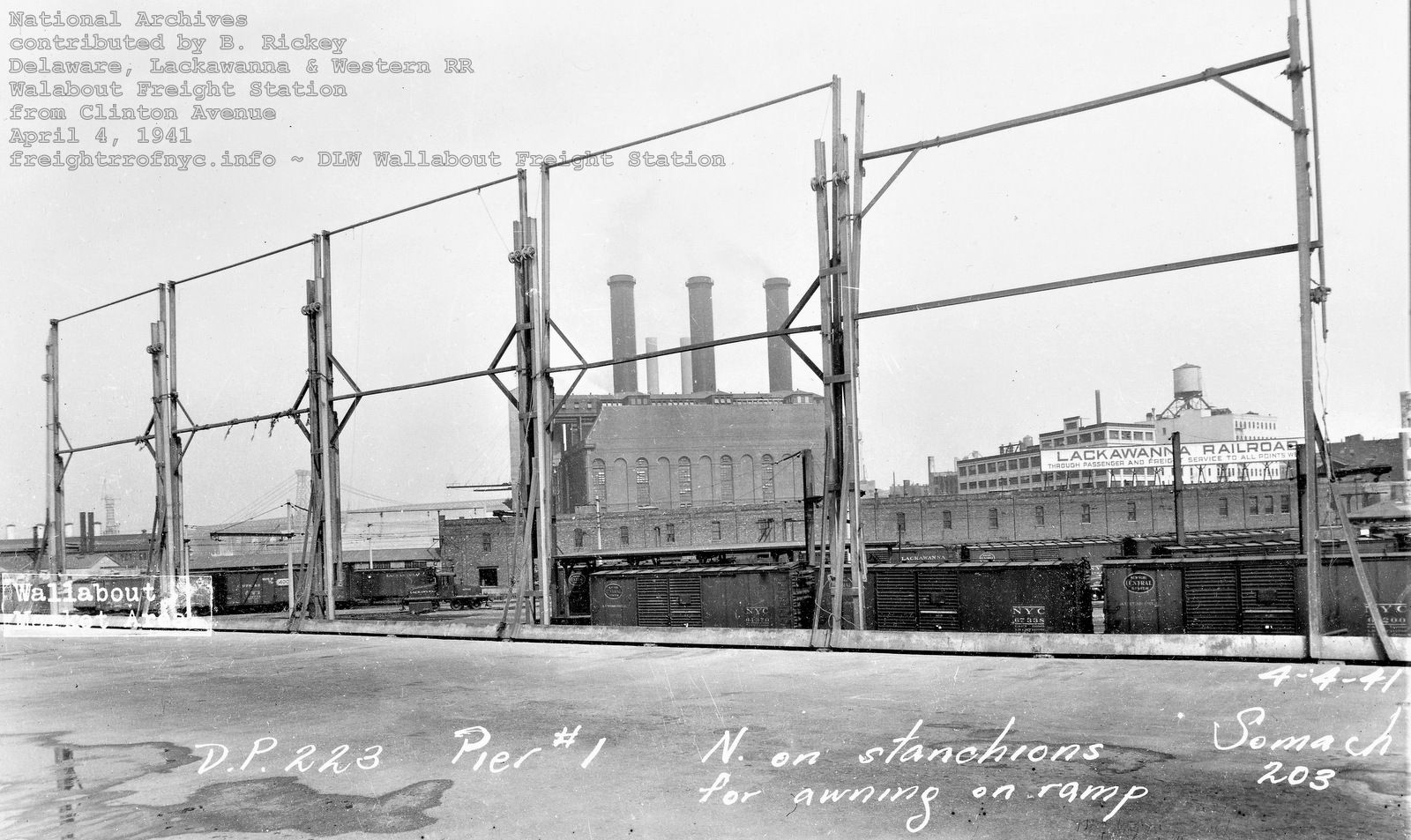
Wallabout Terminal - Delaware, Lackawanna & Western - April 4, 1941
Looking south, taken from roof of Sanitation Pier - Pier 1
Note DLW 4001 steeplecab, New York Central boxcars are on carfloat.
National Archives
image forwarded by Bob Rickey
added 30 October 2022
.
. .
.
The float bridge at the Delaware, Lackawanna & Western Railroad's Wallabout Terminal is now known to have been a wooden Howe Truss throughout the terminal span of operation: 1906 - 1941.
It is also now known that the float bridge at this location employed the use of a metal truss lifting gallows until 1926 when the terminal was electrified. This lifting gallows (only used to raise an unladen float bridge to meet the deck of a high riding carfloat - not for live load) can be seen in the 1913 images in the locomotive chapter.
While this choice of wooden Howe Truss float bridge design by itself is not surprising, what is unusual is the fact that the Delaware, Lackawanna & Western installed overhead trolley wire supports at the time of terminal electrification in 1926. These supports were mounted on top of the wood trusses and spaced along the float bridge at intervals to (what else?) support the trolley wire to the end of the float bridge:
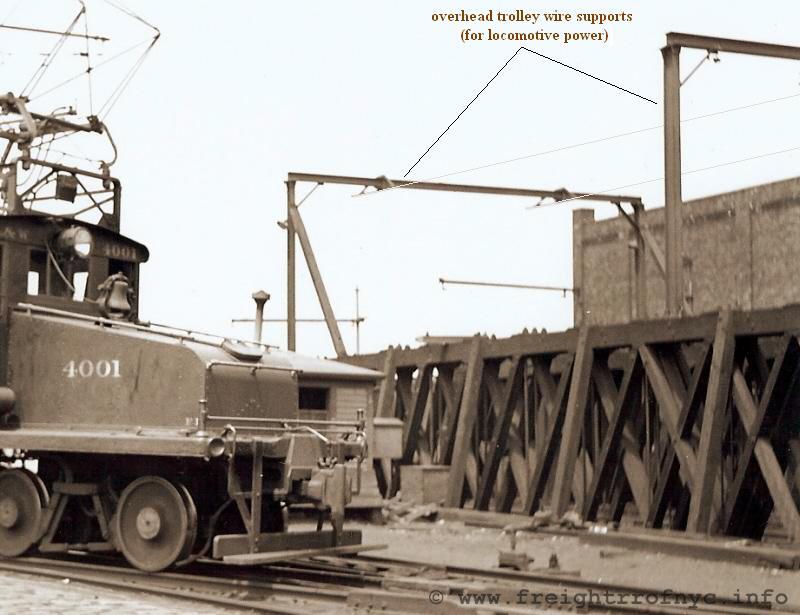
June 4, 1936
.
This type of arrangement is believed to be the only such arrangement used in New York Harbor. But this arrangement also reveals a small (yet easily overcome) obstacle in locomotive / carfloat operations at DLW Wallabout Terminal:
As the trolley wire could not progress past the end of the float bridge, electric locomotive #4001 could not venture out past the float bridge and onto the carfloat to move freight cars. Therefore at least one reacher or idler car was necessary to couple up to remove or place freight cars onto the carfloat.
It is also bears wondering if the choice of float bridge (wood Howe Truss) would have offered additional safety factor (by being non-conductive as opposed to a steel float bridge which would be) and allowing the trolley wire to be mounted in close proximity to water.
.
.
.
Steam: 1906 - 1926
It is now confirmed that prior to 1926 and the enactment of
the Kaufman "anti-smoke" legislation, this terminal employed the use of a
steam powered tank locomotive. Unfortunately, this confirmation comes via
a 1913 construction photo of the Brooklyn Navy Yard, and the locomotive type
and number cannot be discerned.
According to Erie Lackawanna Historical Society, the Delaware,
Lackawanna & Western Railroad only rostered two 0-4-0T locomotives: #4
and #7, and one 0-6-0T: #8. As #4 was built by Rogers in 7/1913. this means
the locomotive in the image cannot be #4 as the image was taken
before the locomotive construction date, and as #7 was not built until
March 1922, that precludes this locomotive from operating here as well at
the time the photos below were taken.
#8 was of 0-6-0T wheel arrangement and was built by Baldwin
in 1904 for Brooklyn Dock & Terminal as their #2. Also, as this terminal
had 40 degree curves, so a 0-6-0T could be used here without issue, especially
with blind (flangeless) center drivers. So there is a remote possibility
this could be that locomotive; however it is believed #8 was operated at
the DL&W 25th Street Terminal also in Brooklyn leaving the present conundrum
of which locomotive this is in the images below.
Then of course is the very real possibility that the locomotive
seen in these images could be either a previously unknown tank locomotive
on the DL&W roster or even a previously unknown shop rebuild. Another
possibility exists: the steam locomotive used here could be Brooklyn Dock
& Terminal #1 (ex-Norfolk & Western #93). This locomotive disappeared
from the 25th Street Terminal around 1906. Very coincidentally, this is the
same year both this Wallabout Terminal opened and the same year Delaware,
Lackawanna & Western took acquired the 25th Street Terminal from Brooklyn
Dock & Terminal.
Furthermore, at such time when the primary steam locomotive
at this location needed major servicing or overhaul, another steam locomotive
would have had to have been provided as temporary replacement.
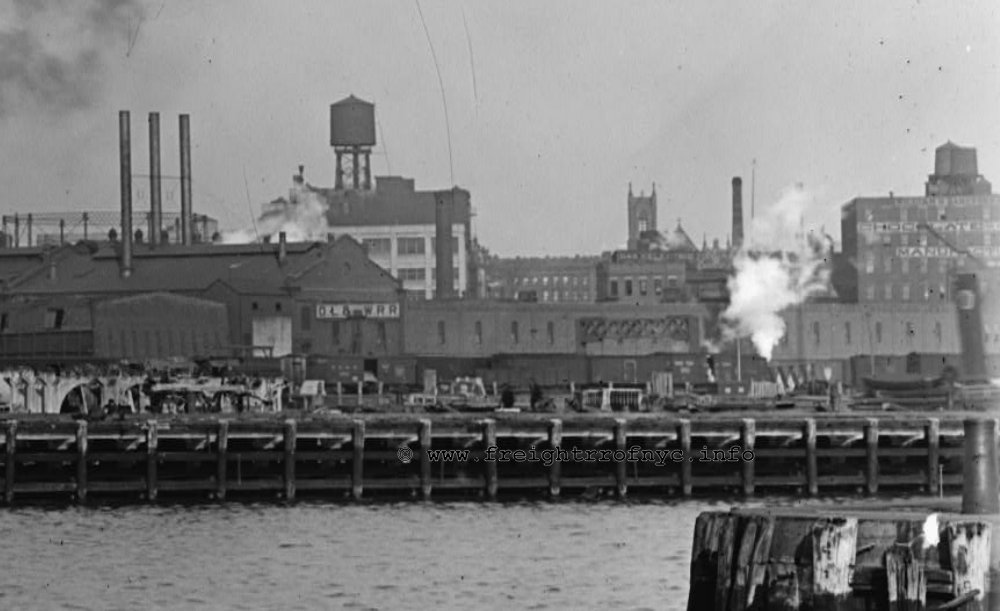
Delaware, Lackawanna & Western steam locomotive
at Wallabout Terminal - 1/21/1913
(Note Howe Truss float bridge, overhead gantry and stack of PRR tug
on right edge of image.)
courtesy of the National
Archives
added 13 March
2015
.
.
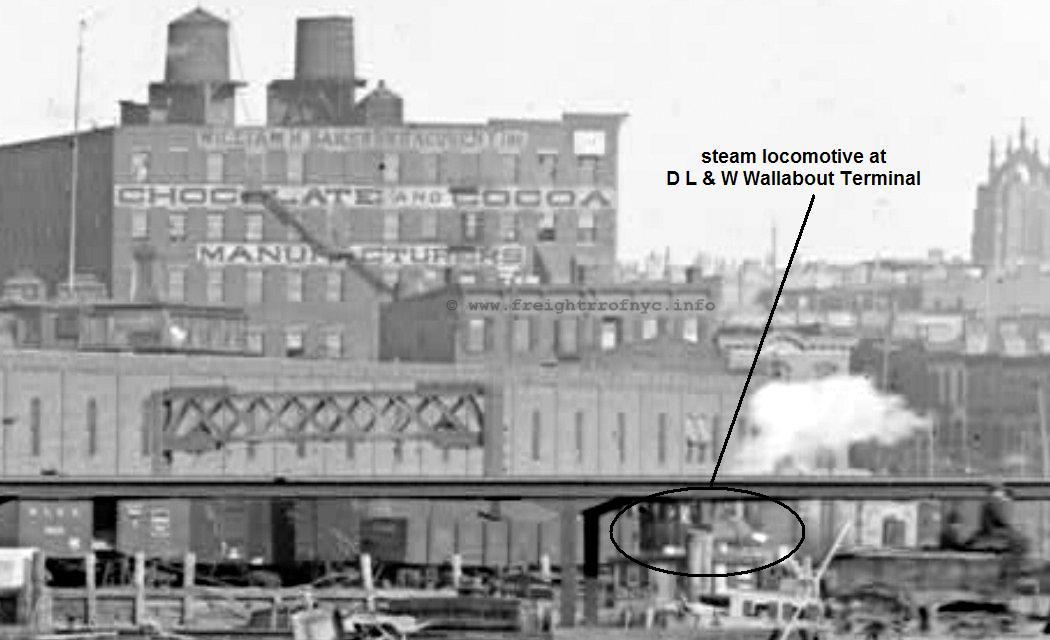
Delaware, Lackawanna & Western steam locomotive at Wallabout Terminal
- 1/21/1913
(partially obscured by passing station carfloat.)
courtesy of the National
Archives
added 13 March
2015
.
.
Electric: 1926 - 1940
After 1926, only one locomotive is known to have been used at this Delaware, Lackawanna & Western facility. This locomotive was an electric powered (via overhead pantograph) steeplecab locomotive.
This locomotive was numbered 4001 and was built in June 1926 by General Electric. This locomotive was unusual in appearance as the pantograph on top of the cab appeared quite large and oversized, when compared to the locomotive itself. Most steeplecab locomotives of this size and manufacture were equipped with much less visible trolley poles (e.g. Bush Terminal and South Brooklyn Railway).
Another unique feature of this particular locomotive, is the "inside frame" truck design with visible brake arms and rigging.
This locomotive would go on to serve this Delaware, Lackawanna & Western Wallabout Terminal until the US Government "seized" the properties surrounding the Wallabout Terminal in 1940, for the purpose of expanding the Brooklyn Navy Yard.
This locomotive was then sold to the Shawinigan Falls Terminal Railway in Quebec, Canada and numbered as their #7; in February 28, 1942. Its current status or disposition is unknown at this time, but according to "Interurban Electric Locomotives from General Electric" by Joseph A. Strapac; disposition is given as being scrapped in 1952.
Again, anyone with information on this locomotive is invited to contact the author at bedt14@aol.com
|
|
| .
. |
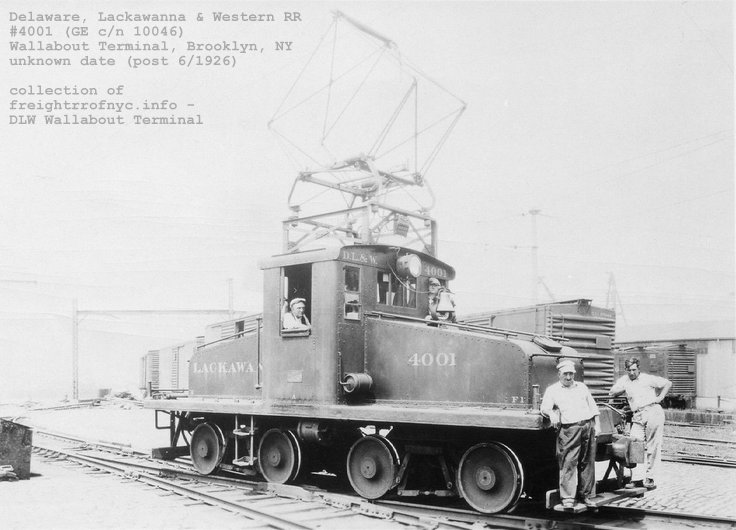 #4001 - unknown date unknown photographer authors collection added 31 October 2022 |
| .
. |
|
|
| .
. |
|
|
| .
. |
|
|
| .
. |
|
|
.
Wallabout Terminal (DL&W)
Roster
| number / name |
builder | c/n | model | build date |
gauge |
wheel arrangement |
wheel dia |
cylinders |
acquired |
disposition |
notes | ref |
| 4 * | ALCo-Rogers | 53119 | 7/1913 | std. | 0-4-0T | 46" | 16" x 24" | new | sold 3/14/42 to Georgia Car & Locomotive (dealer) | |||
| 7 * | Baldwin | 55346 | 3/1922 | 0-4-0T | 44" | 16" x 24" | new |
retired 1949 |
||||
| 8 * | Baldwin | 23868 | 3/1904 | 0-6-0T | 46½" | 19x24 | used Brooklyn Dock & Terminal #2 |
numbered DLW #173, 1906 renumbered #8, 1914 scrapped 9/1926 |
||||
| 4001 | GE | 10046 | steeplecab | 6/1926 | std. | B-B | 36" | new | shipped 6/11/1926 to DLW; Sold 2/28/1942 to Shawinigan Falls Terminal Rwy #7 Quebec, Canada scrapped 1952 |
[a] Westinghouse 516-B pantograph |
[24] [37] |
Locomotive Footnotes
| * | use possible but not confirmed at this location | |
| [a] | weight: motors: gear ratio: |
102,840 lbs. 207G 67:16 |
.
.
.
. .
Marine Equipment
Being a Delaware, Lackawanna & Western Railroad operation, the Wallabout Terminal would have been serviced by Delaware, Lackawanna & Western Railroad tugboats, carfloats and lighters.
Keeping in mind the significant amount of marine equipment that the Delaware, Lackawanna & Western Railroad owned and operated, and not knowing if there was equipment specifically assigned to this facility (it is highly unlikely they did), a Tugboat Roster on this website would not be beneficial or justified; and therefore will not be forthcoming.
.
.
. .
Like what you see? Suggestions? Comments?